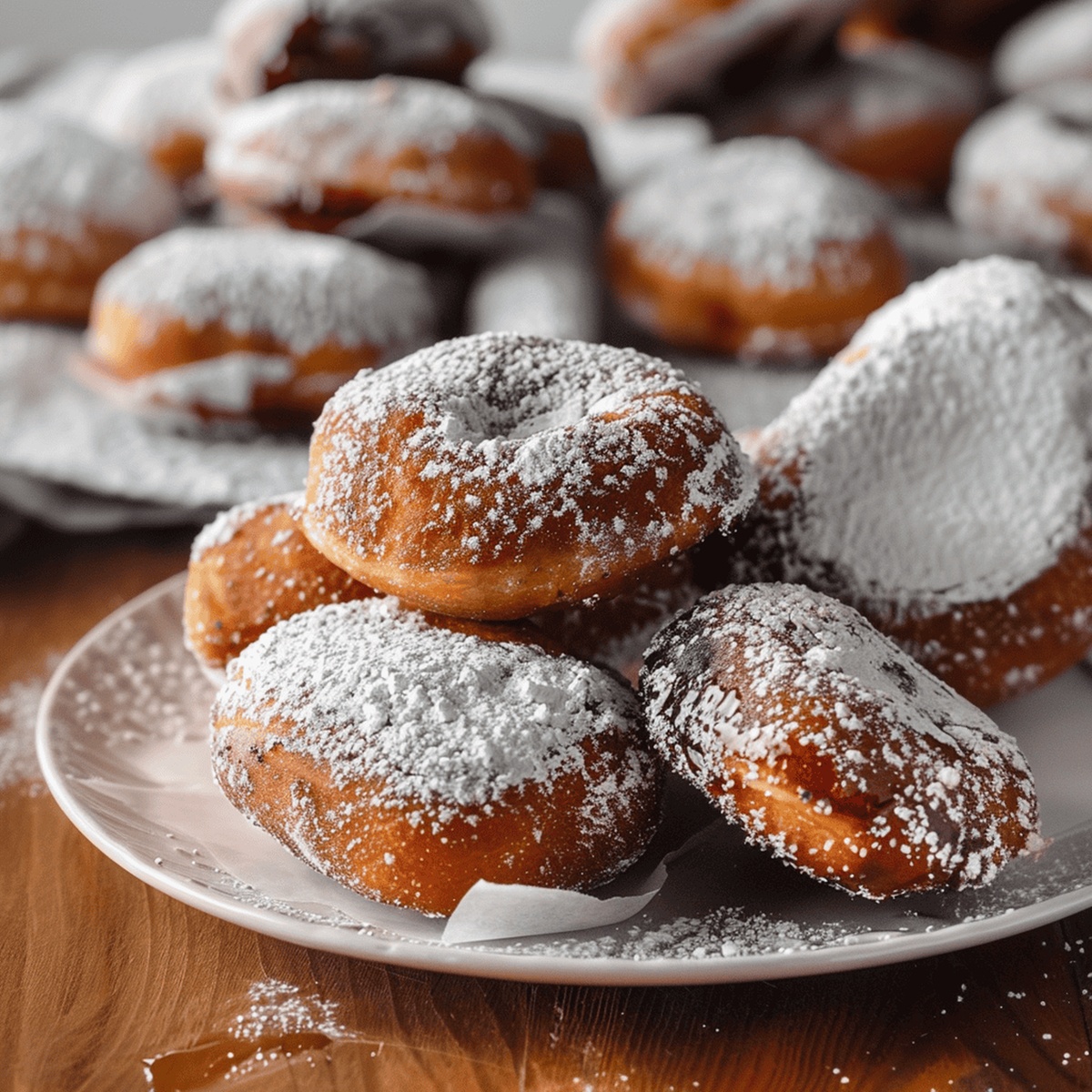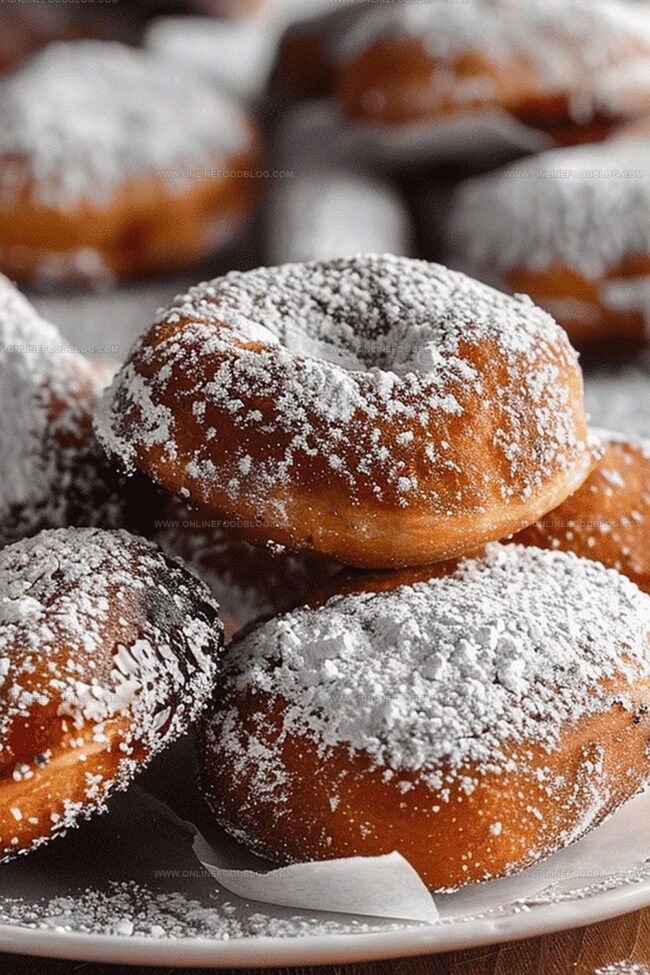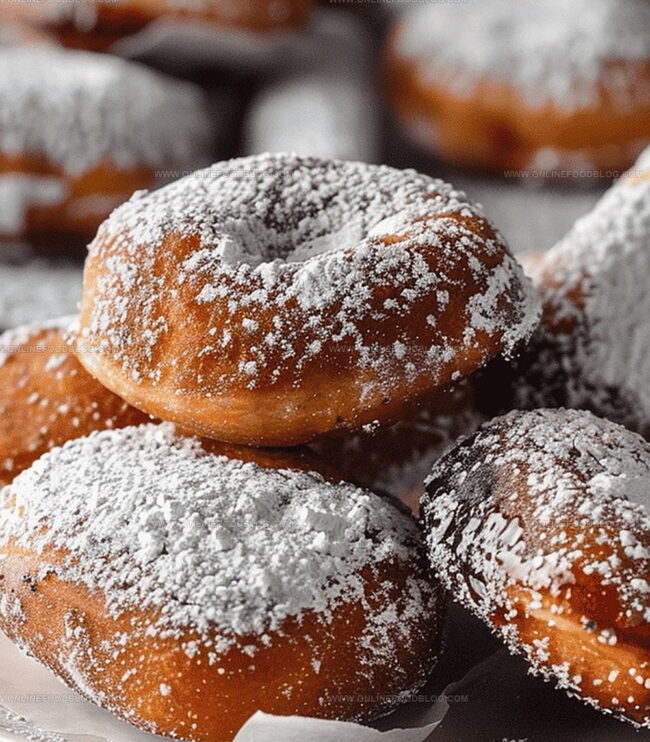Fluffy Classic French Beignets Recipe: Sweet Cafe-Style Treats
These delectable classic French beignets represent a culinary treasure that transcends mere pastry.
Sweet, pillowy squares of pure indulgence have captivated taste buds across generations.
Crisp exterior and soft interior create a delightful textural contrast that makes them irresistible.
Generations of bakers have perfected this magical treat through generations of passionate craftsmanship.
Southern French traditions infuse these delicate morsels with a rich cultural heritage that speaks to comfort and celebration.
Powdered sugar reimagines these golden-brown delights into a visual spectacle that beckons food lovers.
The magic happens when simple ingredients combine with precise technique, turning ordinary components into extraordinary pleasure.
The French Treat That’s Always in Fashion
Everything You Need for Airy Beignets
Main Ingredients:
Flour Mixture:Liquid and Leavening Ingredients:Finishing and Coating Ingredients:How to Fry Up a Batch Without Fuss
Step 1: Activate Yeast
Gently warm milk in a saucepan to 105°F. Sprinkle sugar and yeast into the warm milk. Let the mixture sit and become frothy for 10 minutes.
Step 2: Create Dough Base
In a large mixing bowl, combine:Crack eggs into the bowl and pour in the milk-yeast mixture. Mix until a soft dough forms.
Step 3: Knead and Develop Texture
Slowly incorporate butter into the dough, kneading until smooth and slightly tacky. This process develops rich flavor and perfect consistency.
Step 4: First Dough Rise
Cover the dough and let it rest in a warm spot for 2 hours. The dough will double in size and become puffy.
Step 5: Shape Beignet Discs
Punch down the risen dough. Roll out on a floured surface and cut into round discs.
Step 6: Second Rise
Allow shaped discs to rise for 30 minutes, becoming light and airy.
Step 7: Fry to Golden Perfection
Heat oil to 350°F. Carefully fry each disc until they turn beautiful golden brown.
Step 8: Final Touch
Generously dust fried beignets with powdered sugar. Optional: Fill with jam using a piping bag for extra deliciousness.
Tips for Beignets That Taste Like Paris
Save and Reheat Like a Beignet Boss
Pairing Ideas for Café-Style Bites
New Takes on the French Classic
Print
Classic French Beignets Recipe
- Total Time: 2 hours 50 minutes
- Yield: 12 1x
Description
Crisp, pillowy French beignets offer a delightful New Orleans-inspired treat that transports taste buds to charming Parisian cafes. Light powdered sugar dusts these golden squares, inviting you to savor each delectable, melt-in-your-mouth bite of sweet culinary magic.
Ingredients
Main Ingredients:
- 4 cups (500g) all-purpose flour
- 2 large eggs
- 1 cup milk (2% or whole)
- 85 g unsalted butter
Leavening and Seasoning:
- 1 packet (8g) traditional yeast (active dry)
- 1 teaspoon (5.7g) salt
- ¼ cup (50g) sugar
- 1 tablespoon (15g) sugar
Coating and Frying:
- ½ cup (100g) sugar for coating
- 6 to 8 cups vegetable oil for frying
- 1 cup raspberry jam (or any filling of your choice)
Instructions
- Gently heat milk in a small saucepan, incorporating yeast and of sugar. Warm the mixture to precisely 105°F (40.5°C), creating an ideal environment for yeast activation. Allow the mixture to rest and become frothy for 10 minutes.
- In a spacious mixing bowl, thoroughly combine flour, a pinch of salt, and of sugar. Create a well in the center and crack fresh eggs into it. Pour the activated yeast mixture into the flour, blending carefully until a cohesive dough forms.
- Incrementally incorporate softened butter into the dough, kneading methodically. Continue working the dough until it reaches a smooth, slightly tacky consistency that springs back when touched.
- Transfer the dough to a lightly greased bowl, cover with a damp kitchen towel, and allow it to rise in a warm, draft-free location for approximately 2 hours. The dough should double in volume and appear puffy.
- Deflate the risen dough by gently pressing down. Roll out the dough on a lightly floured surface to approximately 1/4 inch (6 millimeters) thickness. Cut into uniform circular discs using a round cookie cutter.
- Arrange the dough discs on a parchment-lined baking sheet, ensuring they are not touching. Let them undergo a second rise for 30 minutes, becoming slightly puffy and light.
- Heat vegetable or canola oil in a deep, heavy-bottomed pot to 350°F (175°C), monitoring temperature with a candy thermometer. Carefully lower the dough discs into the hot oil, frying until they transform into a rich golden brown color.
- Remove the beignets using a slotted spoon, allowing excess oil to drain. Immediately coat with a generous dusting of powdered sugar while still warm.
- For a delightful variation, use a piping bag to inject small amounts of fruit jam into the center of each beignet, creating a surprise filling that complements the crisp, sugary exterior.
Notes
- Activate yeast properly by warming milk to the right temperature, ensuring a perfect rise for light, fluffy beignets.
- Patience is key during the rising process, allowing the dough to develop rich flavors and tender texture.
- Use a candy thermometer to monitor oil temperature, preventing soggy or burnt pastries.
- Dust beignets generously with powdered sugar immediately after frying for an authentic New Orleans-style treat.
- Experiment with sweet fillings like fruit jam or chocolate cream to personalize your homemade beignets.
- Serve warm for the most delightful crispy-soft experience that melts in your mouth.
- Prep Time: 2 hours 45 minutes
- Cook Time: 5 minutes
- Category: Desserts, Snacks
- Method: Frying
- Cuisine: French
Nutrition
- Serving Size: 12
- Calories: 302 kcal
- Sugar: 18 g
- Sodium: 204 mg
- Fat: 15 g
- Saturated Fat: 7 g
- Unsaturated Fat: 6 g
- Trans Fat: 0.3 g
- Carbohydrates: 37 g
- Fiber: 1 g
- Protein: 5 g
- Cholesterol: 55 mg




Lucas Bennett
Founder & Recipe Creator
Expertise
Simple Everyday Recipes, Sustainable Cooking Practices, Creative Meal Planning, Recipe Testing and Improvement
Education
Fox Valley Technical College, Appleton, Wisconsin
Lake Superior College, Duluth, Minnesota
Lucas Bennett’s cooking journey started in his parents’ kitchen, where he learned to prepare tasty, no-fuss meals from scratch. His culinary passion led him to Fox Valley Technical College, where he gained practical cooking skills.
He then expanded his focus on sustainability at Lake Superior College. Today, Lucas shares easy, approachable recipes designed to make cooking enjoyable and stress-free for everyone.